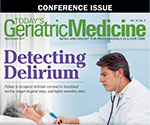 |
New research suggests that if chronic sleep disturbance can be identified as a newly discovered risk factor for osteoporosis, it might help to explain the lack of cause for osteoporosis in the estimated 54 million Americans with low bone mass. A recent study found that several weeks of cumulative sleep restriction and circadian disruption resulted in reduced levels of a marker of bone formation in their blood.
In addition to reading our e-newsletter, be sure to visit Today’s Geriatric Medicine’s website at www.TodaysGeriatricMedicine.com, where you’ll find news and information that’s relevant and reliable. We welcome your feedback at TGMeditor@gvpub.com. Follow Today’s Geriatric Medicine on Facebook and Twitter, too.
— Barbara Worthington, editor |
 |
 |
Prolonged Sleep Disturbance Can Lead to Lower Bone Formation
Insufficient sleep, a common problem that has been linked to chronic disease risk, might be an unrecognized risk factor for bone loss. Results of a new study were presented at the Endocrine Society’s 99th annual meeting in Orlando, Florida.
The study investigators found that healthy men had reduced levels of a marker of bone formation in their blood after three weeks of cumulative sleep restriction and circadian disruption, similar to that seen in jet lag or shift work, while a biological marker of bone resorption, or breakdown, was unchanged.
“This altered bone balance creates a potential bone loss window that could lead to osteoporosis and bone fractures,” says lead investigator Christine Swanson, MD, an assistant professor at the University of Colorado in Aurora. Swanson completed the research while she was a fellow at Oregon Health & Science University in Portland, Oregon, with Eric S. Orwoll, MD, and Steven A. Shea, PhD.
“If chronic sleep disturbance is identified as a new risk factor for osteoporosis, it could help explain why there is no clear cause for osteoporosis in the approximately 50% of the estimated 54 million Americans with low bone mass or osteoporosis,” Swanson says.
Full story » |
 |
 |
Differentiating Dementias: Alzheimer’s Disease and Its Management
The incidence of dementia, which occurs in several forms, continues to increase as the elder population expands. Properly identifying the type of dementia and promptly initiating appropriate treatment are essential to proper management. Read more »
Insomnia in Older Adults
Providers must recognize that sleep difficulties resulting in daytime functional concerns require identification and appropriate interventions. Read more »
Identifying Lewy Body Dementia
Lewy body dementia’s symptoms present similarly to Parkinson’s disease and the early stages of Alzheimer’s disease, making diagnosis difficult in a clinical setting. Read more » |
 |
|
|
 |
Testosterone Therapy Is Popular,
but Studies Are Mixed
Physicians must weigh the benefits and risks before prescribing testosterone therapy, according to an article in The New York Times.
‘Prehospice’ Saves Money by Keeping People at Home Near the End of Life
Prehospice care offers support for patients nearing the end of life, while saving money at the same time, according to an article at Kaiser Health News.
Virginia Doctor Finds a Treatment for Sepsis
A Pilot Online article suggests that a Norfolk physician has stumbled on an answer to the perplexing question of sepsis treatment.
UPMC Shadyside Focuses on Preventing Patients’ Delirium
According to an article in the Pittsburgh Post-Gazette, an innovative hospital program seeks to identify and/or prevent older adults’ delirium. |
 |
|
